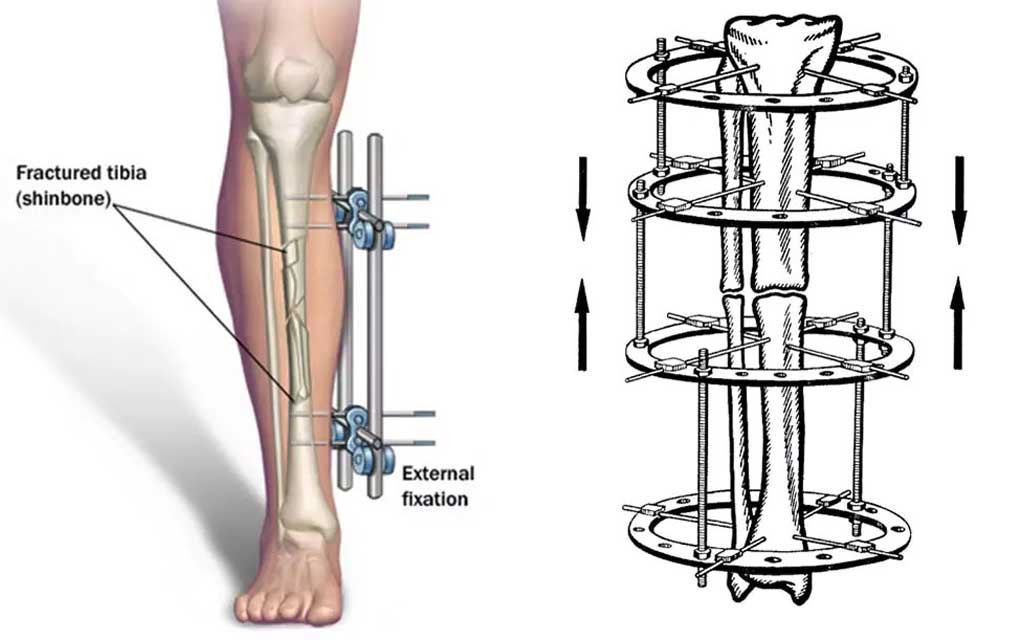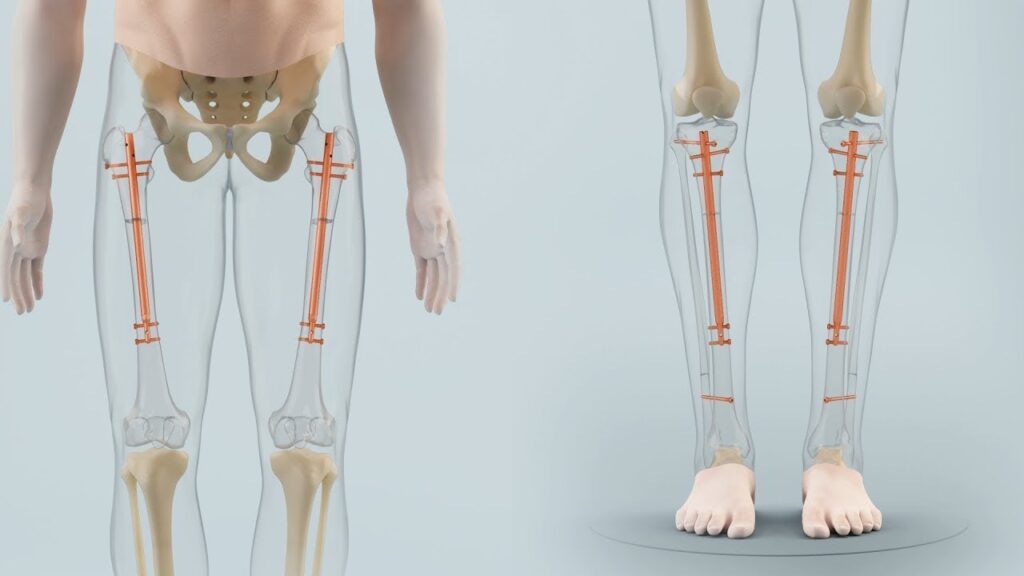Discover the history and evolution of limb-lengthening surgery, exploring its origins, advancements, and impact on modern medicine.

Outline
| Headings | Sub-Headings |
|---|---|
| Introduction | – |
| The Origins of Limb-Lengthening Surgery | – Ancient Techniques |
| – Early Discoveries and Experimentation | |
| Pioneering Surgeons and Their Contributions | – Ilizarov Method |
| – Other Notable Surgeons | |
| Technological Advancements | – Development of External Fixators |
| – Intramedullary Lengthening Nails | |
| Modern Techniques and Procedures | – Minimally Invasive Methods |
| – Combined Techniques | |
| Clinical Applications | – Correcting Congenital Deformities |
| – Trauma Recovery | |
| – Cosmetic Procedures | |
| Challenges and Complications | – Common Risks |
| – Psychological Considerations | |
| Success Stories | – Patient Testimonials |
| – Medical Case Studies | |
| Future Directions | – Emerging Technologies |
| – Potential for Genetic Engineering | |
| Ethical Considerations | – Medical Ethics |
| – Social Implications | |
| Global Perspectives | – Practices in Different Cultures |
| – International Medical Standards | |
| Cost and Accessibility | – Financial Barriers |
| – Accessibility in Developing Countries | |
| Patient Selection Criteria | – Medical Evaluation |
| – Psychological Screening | |
| Rehabilitation and Recovery | – Physical Therapy |
| – Post-Surgery Care | |
| Impact on Quality of Life | – Physical Benefits |
| – Psychological Benefits | |
| Comparative Analysis | – Limb-Lengthening vs. Other Orthopedic Surgeries |
| – Success Rates | |
| Regulatory and Legal Aspects | – Medical Regulations |
| – Legal Considerations | |
| Public Perception and Awareness | – Media Representation |
| – Public Health Campaigns | |
| Educational Resources | – Books and Publications |
| – Online Resources | |
| Conclusion | – |
| FAQs | – |
| – What is limb-lengthening surgery? | |
| – How has limb-lengthening surgery evolved? | |
| – What are the risks of limb-lengthening surgery? | |
| – How long is the recovery period? | |
| – Who is a candidate for limb-lengthening surgery? | |
| – What advancements are expected in the future? |
The Fascinating History and Evolution of Limb-Lengthening Surgery
Limb-lengthening surgery has undergone significant advancements since its inception, evolving from rudimentary methods to sophisticated techniques that enhance patients’ quality of life. This article delves into the origins, pioneers, technological advancements, modern procedures, and future directions of limb-lengthening surgery, providing a comprehensive overview of this fascinating medical field.
Introduction
Limb-lengthening surgery, a remarkable innovation in orthopedic medicine, enables patients to gain increased limb length, improving functionality and aesthetics. This procedure has a rich history marked by innovative techniques and pioneering surgeons who have significantly impacted modern medical practices.
The Origins of Limb-Lengthening Surgery
Ancient Techniques
The concept of limb-lengthening dates back to ancient civilizations. Early attempts included the use of traction and splints, albeit with limited success. Ancient methods were rudimentary and often fraught with complications, reflecting a time when medical knowledge and technology were in their infancy.
Early Discoveries and Experimentation
In the late 19th and early 20th centuries, significant strides were made in orthopedic surgery. Surgeons began experimenting with osteotomy techniques, where bones were cut and gradually lengthened. These early procedures laid the groundwork for future advancements.
Pioneering Surgeons and Their Contributions
Ilizarov Method
Dr. Gavriil Ilizarov, a Soviet orthopedic surgeon, revolutionized limb-lengthening surgery in the 1950s with his innovative method. The Ilizarov technique, involving the use of external fixators to gradually stretch bone, remains a cornerstone of limb-lengthening procedures.

Other Notable Surgeons
Other pioneers, such as Dr. Alexander Bliskunov and Dr. Jean-Pierre Masson, made significant contributions to the field. Their work in developing new techniques and refining existing ones has been instrumental in advancing limb-lengthening surgery.
Technological Advancements
Development of External Fixators
The development of external fixators marked a significant leap in limb-lengthening surgery. These devices allowed for precise control over the lengthening process, reducing complications and improving outcomes.
Intramedullary Lengthening Nails
Intramedullary lengthening nails, a more recent innovation, are inserted inside the bone. These devices have made the procedure less invasive and more comfortable for patients, representing a major advancement in the field.
Modern Techniques and Procedures
Minimally Invasive Methods
Modern limb-lengthening techniques emphasize minimally invasive approaches. These methods reduce surgical trauma, minimize scarring, and shorten recovery times, enhancing the overall patient experience.
Combined Techniques
Combining different techniques, such as using both external fixators and intramedullary nails, can optimize results. These combined approaches offer greater flexibility and precision in achieving desired outcomes.
Clinical Applications
Correcting Congenital Deformities
Limb-lengthening surgery is often used to correct congenital deformities, such as limb length discrepancies and skeletal dysplasia. These procedures can significantly improve mobility and quality of life for affected individuals.
Trauma Recovery
In cases of severe trauma resulting in limb shortening, limb-lengthening surgery can restore normal length and function. This application is crucial for patients recovering from accidents or injuries.
Cosmetic Procedures
Beyond medical necessity, limb-lengthening surgery is sometimes sought for cosmetic reasons. Individuals may opt for the procedure to increase height or improve the symmetry of their limbs.
Challenges and Complications
Common Risks
Like any surgical procedure, limb-lengthening surgery carries risks. Common complications include infection, nerve damage, and joint stiffness. However, advancements in technology and surgical techniques have reduced these risks significantly.
Psychological Considerations
The psychological impact of limb-lengthening surgery should not be underestimated. Patients must undergo thorough psychological evaluation and counseling to ensure they are prepared for the physical and emotional challenges of the procedure.
Success Stories
Patient Testimonials
Many patients who have undergone limb-lengthening surgery share inspiring stories of transformation. These testimonials highlight the profound impact the surgery has had on their lives, from increased mobility to improved self-esteem.
Medical Case Studies
Medical case studies provide valuable insights into the outcomes of limb-lengthening procedures. These studies demonstrate the effectiveness of various techniques and help guide future advancements in the field.
Future Directions
Emerging Technologies
The future of limb-lengthening surgery looks promising with the advent of new technologies. Innovations such as 3D printing and robotics are poised to enhance precision and outcomes.
Potential for Genetic Engineering
While still in the realm of speculation, genetic engineering holds potential for future developments in limb-lengthening. Research in this area could lead to groundbreaking advancements in treating congenital deformities and growth deficiencies.
Ethical Considerations
Medical Ethics
Ethical considerations are paramount in limb-lengthening surgery. Issues such as informed consent, patient autonomy, and the potential for misuse must be carefully navigated by medical professionals.
Social Implications
The social implications of limb-lengthening surgery extend beyond the individual. Societal attitudes towards height and physical appearance can influence the demand for these procedures, raising important questions about body image and societal norms.
Global Perspectives
Practices in Different Cultures
Limb-lengthening surgery is practiced differently across cultures. Understanding these cultural variations provides a broader perspective on the global impact and acceptance of the procedure.
International Medical Standards
International medical standards ensure the safety and efficacy of limb-lengthening procedures. Adherence to these standards is crucial for maintaining high levels of patient care and surgical success.
Cost and Accessibility
Financial Barriers
The cost of limb-lengthening surgery can be prohibitive for many patients. Financial barriers must be addressed to make this life-changing procedure more accessible to those in need.
Accessibility in Developing Countries
In developing countries, access to limb-lengthening surgery is limited. Efforts to improve accessibility and provide affordable options are essential for global health equity.
Patient Selection Criteria
Medical Evaluation
Thorough medical evaluation is critical in determining candidacy for limb-lengthening surgery. Factors such as overall health, bone quality, and the presence of underlying conditions must be carefully assessed.
Psychological Screening
Psychological screening ensures that patients are mentally prepared for the demands of limb-lengthening surgery. This step is crucial for achieving successful outcomes and patient satisfaction.
Rehabilitation and Recovery
Physical Therapy
Physical therapy is a vital component of the recovery process. It helps patients regain strength, flexibility, and function, ensuring optimal results from the surgery.
Post-Surgery Care
Post-surgery care includes monitoring for complications, managing pain, and providing support throughout the recovery journey. Comprehensive care plans are essential for patient well-being.
Impact on Quality of Life
Physical Benefits
The physical benefits of limb-lengthening surgery are profound. Patients often experience increased mobility, reduced pain, and improved physical function, enhancing their overall quality of life.
Psychological Benefits
Psychological benefits, such as improved self-esteem and confidence, are equally important. Limb-lengthening surgery can have a transformative impact on patients’ mental health and well-being.
Comparative Analysis
Limb-Lengthening vs. Other Orthopedic Surgeries
Comparing limb-lengthening surgery to other orthopedic procedures provides valuable insights into its unique benefits and challenges. This analysis helps patients and healthcare providers make informed decisions.
Success Rates
Success rates for limb-lengthening surgery have improved significantly over the years. High success rates reflect the advancements in surgical techniques and technology.
Regulatory and Legal Aspects
Medical Regulations
Strict medical regulations govern limb-lengthening surgery, ensuring patient safety and procedural efficacy. Compliance with these regulations is essential for maintaining high standards of care.
Legal Considerations
Legal considerations, such as malpractice and patient rights, play a crucial role in limb-lengthening surgery. Understanding these legal aspects is important for both patients and practitioners.
Public Perception and Awareness
Media Representation
Media representation of limb-lengthening surgery influences public perception. Positive and accurate portrayals can help raise awareness and reduce stigma associated with the procedure.
Public Health Campaigns
Public health campaigns are vital for educating the public about limb-lengthening surgery. These campaigns can promote understanding, acceptance, and informed decision-making.
Educational Resources
Books and Publications
Numerous books and publications provide in-depth information about limb-lengthening surgery. These resources are valuable for patients, healthcare providers, and researchers.
Online Resources
Online resources, including websites, forums, and videos, offer accessible information about limb-lengthening surgery. These platforms can connect patients with communities and support networks.
Conclusion
The history and evolution of limb-lengthening surgery is a testament to human ingenuity and medical advancement. From ancient techniques to modern innovations, this field continues to transform lives and push the boundaries of what is possible in orthopedic medicine.
FAQs
What is limb-lengthening surgery?
Limb-lengthening surgery is a medical procedure that involves stretching the bones in the arms or legs to increase their length. This surgery can correct deformities, aid in trauma recovery, or be performed for cosmetic reasons.
How has limb-lengthening surgery evolved?
Limb-lengthening surgery has evolved from ancient methods of traction to advanced techniques like the Ilizarov method and intramedullary lengthening nails. These advancements have improved safety, efficacy, and patient outcomes.
What are the risks of limb-lengthening surgery?
Risks include infection, nerve damage, joint stiffness, and psychological challenges. However, advancements in surgical techniques and technology have significantly reduced these risks.
How long is the recovery period?
Recovery from limb-lengthening surgery can take several months to a year. The exact duration depends on the length of bone being lengthened, the patient’s overall health, and adherence to post-surgery care protocols.
Who is a candidate for limb-lengthening surgery?
Candidates include individuals with congenital deformities, trauma-induced limb shortening, or those seeking cosmetic improvement. Thorough medical and psychological evaluations are essential to determine suitability.
What advancements are expected in the future?
Future advancements may include the use of 3D printing, robotics, and potentially genetic engineering. These technologies promise to enhance precision, reduce recovery times, and improve overall outcomes in limb-lengthening surgery.
Conclusion
Limb-lengthening surgery represents a significant advancement in orthopedic medicine, offering profound benefits for patients with congenital deformities, trauma, or those seeking cosmetic improvements. As technology continues to evolve, the future of limb-lengthening surgery holds even greater promise for enhancing patient outcomes and quality of life.



